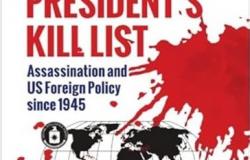Book Review - The President’s Kill List: Assassination and US Foreign Policy since 1945

The President’s Kill List: Assassination and US Foreign Policy since 1945 by Luca Trenta. Edinburgh: Edinburgh University Press, 2024. 400 pp., £95 hardcover 9781399519496, £25 e-book 9781399519526
What is the object of politics? For some, it entails a search for the common good; for others, it involves the pragmatic management of contingency. For American national security officials, it also sometimes involves assassinating people. Such is the conclusion of Luca Trenta’s The President’s Kill List, a whirlwind history of more or less fanciful killing methods, coup attempts, and airstrikes in American foreign policy since the beginnings of the Cold War. For Trenta, this history reveals an unsavoury, yet unmistakable, constant in American foreign policy: the United States government has, at all times since the end of World War II, considered foreign assassination to be part of the portfolio of policy options. As Trenta makes clear, assassination is simultaneously the ‘third rail’ of American politics and a core part of foreign policy: rarely – if ever – explicitly endorsed, often uncomfortably discussed through euphemisms and half-truths, but almost always entertained as a possibility.
 Starting from the early days of the Cold War, where the Central Intelligence Agency (CIA) saw itself as on the frontlines of a covert war (p. 25), The President’s Kill List surveys how assassination became, in effect, a normal part of American policy, simultaneously as the American government ever more strenuously insists that it does not engage in its practice.
Starting from the early days of the Cold War, where the Central Intelligence Agency (CIA) saw itself as on the frontlines of a covert war (p. 25), The President’s Kill List surveys how assassination became, in effect, a normal part of American policy, simultaneously as the American government ever more strenuously insists that it does not engage in its practice.
For Trenta, this is a story characterised mostly by continuity rather than breaks. The early plots – Patrice Lumumba in Congo (Ch. 2), Fidel (and Raul) Castro in Cuba (Ch. 3), Rafael Trujillo in the Dominican Republic (Ch. 4), Ngo Dinh Diem in South Vietnam (Ch. 6) – were mainly articulated through the bipolar confrontation of the Cold War. In all these cases, assassination formed a part of broader attempt at regime change. American involvement ranged from direct planning in rare cases (Lumumba, some of the Castro plots) to indirect enabling through money, weapons delivery, and political support. At the indirect extreme, such as the killing of General René Schneider as part of a coup attempt against Salvador Allende in Chile (Ch. 6), the CIA and American government rather adopted a position of allowing a coup to proceed in the knowledge that it would very likely result in the killing of its targets.
Through these plots, Trenta centres the interaction between the CIA and the political administrators. This relation – as the role of other government agencies – is by no means uncomplicated. While he argues for a certain consistency in the appeal of covert action, legal and policy debates remained vigorously contested between political and intelligence circles. While presidential administrations varied in their support for covert action – though, generally, most were rather encouraging of it – Trenta rejects any suggestion of political ignorance: through a careful and discerning reading of the historical record, he demonstrates decisively that presidents and their closest advisors invariably were aware of assassination plans, if not likely ordering them (see Ch. 2 on Patrice Lumumba). Notably, other agencies such as the State department and the Department of Defense varied in their attitudes, sometimes spurring regime change, sometimes acting as a brake on runaway plotting.
At the centre of this story lies the 1975 Church Senate Committee investigation into illegal activities at the CIA (Ch. 7), its damning report on assassination, and the series of three executive orders (Gerald Ford’s 11905, Jimmy Carter’s 12036 and Ronald Reagan’s 12333) banning assassination. Trenta charts the interplay between policy, legality, and (more rarely) morality concerns shaping discussions, as well as the camouflaging layers of (plausible or implausible) deniability, euphemisms, strategic denials, and deliberate ignorance which made killing as a policy option possible. Following the 1976 promulgation of the first executive order banning political assassination, Trenta notes how successive administrations – with the exception of Carter’s – engaged in successive reinterpretations of the Ban to make political killing legal, now within the frameworks of counter-narcotics and counter-terrorism operations. In other words, having banned assassination, foreign policy makers got to work to make acceptable forms of political killing which would lie outside the remit of the ban. The result is a recurring play of plausible deniability of lethal intent (for instance concerning Muhammar Qaddafi and Afghanistan, Ch. 8) and variously in/direct support for internal coups (Panama, Ch. 9 and Iraq, Ch. 10). The main consequence of the assassination ban, however, lay in the sprawling legal architecture built successively from the Reagan years onwards to enable these operations, denying that they constituted assassinations at all.
Some – though not all – of these operations moved into the open. Qaddafi was targeted by large airstrikes, as was Saddam Hussein five years later. Simultaneously as political killings moved into the open, their legal justifications burrowed into secrecy. The legal justifications for these killing attempts lie, as Trenta notes, in an uneven patchwork of public declarations, counterterrorism policy documents, and classified intelligence findings, memorandums of notification, and Office of Legal Counsel memos. As Matthew Fuller and Eyal Weizman note, no matter how hidden secrets may be, they always leave traces of their existence, elusive presences pointing to what is hidden.[i] Through an impressive array of sources, high-level interviews with CIA and White House officials, memoirs, public documents and historical records, Trenta reconstructs the contours of the debates, arguments, and positions which shape policies of lawful assassination, noting contradictions, revelations, and uncertainties which necessarily pervade the study of secret operations.
For Trenta, this reconstruction of legal killing post-1975 is best grasped as a process of norm contestation, of which he identifies three axes: meaning contestation, applicability contestation, and validity contestation (p. 357). Meaning contestation addresses the central ambiguity of political assassination: what is it, and what constitutes involvement in assassination? Deniability, intent-masking, and strategic ignorance here allowed United States officials to tacitly condone killing without doing so by denying that killing was the overt objective of any operation. Applicability contestation, meanwhile, addressed the remit of the ban: by constraining its applicability, excluding counter-terrorism operations and operations undertaken in self-defence against (elongated or ongoing) imminent threats, legal advisors in effect constituted categories of political killing that would not be assassinations at all.
The last form of contestation, validity contestation, addresses the wisdom of the ban itself: should assassination be banned at all? Here, Trenta suggests, there remains an underlying agreement in American foreign policy circles: sometimes, killing opponents is necessary, advisable, or even good. Fundamentally, Trenta argues, assassination has always constituted a policy option for American presidents, along various degrees of covert, military, and diplomatic action,[ii] a “silver bullet” (p. 276, 350) to solve crises on the cheap.
Trenta’s book is part of a trilogy of outstanding books on American covert killings published in the last decade, alongside Marcus Gunneflo’s Targeted Killing: A Legal and Political History[iii] and Christopher Fuller’s See it/Shoot it[iv]. Trenta, by comparison, adopts a wider lens both by starting his history earlier (in the early Cold War rather than in the Reagan administration) and by writing a deliberately political history. Without discounting the legal excavations which characterise Gunneflo’s work, the protagonists of Trenta’s works are policy advisors, CIA leaders, and presidents. Similarly to Fuller’s work, The President’s Kill List combines rich historical detail and fine analysis to highlight the centrality of covert lethal action in American foreign policy and trace how it came to become a normalised – though never settled – part of the duties and prerogatives of the President.
Emil Archambault is an Addison Wheeler Postdoctoral Fellow at the School of Government and International Affairs, Durham University His research addresses historical and conceptual developments in practices of remote warfare, particularly the use of armed drones in contemporary war. He is currently conducting a project on “Democratic Contestations of Remote Warfare,” as well as work on the epistemology of future war.
[i] Matthew Fuller and Eyal Weizman, Investigative Aesthetics: Conflicts and Commons in the Politics of Truth (New York: Verso, 2021), 113–18.
[ii] In two of the cases – Ch. 9 on Manuel Noriega and Ch. 10 on Saddam Hussein, failures of assassinations were followed by conventional military action. The same can be said for the failed killing of Osama Bin Laden in the 1990s and early 2000s.
[iii] Markus Gunneflo, Targeted Killing: A Legal and Political History (Cambridge: Cambridge University Press, 2016).
[iv] Christopher J Fuller, See It/Shoot It: The Secret History of the CIA’s Lethal Drone Program (New Haven: Yale University Press, 2017). My review of Fuller’s book is available here: Emil Archambault, ‘Review of Chris Fuller, See It/Shoot It: The Secret History of the CIA’s Lethal Drone Program’, International Affairs 94, no. 1 (1 January 2018): 227–28, https://doi.org/10.1093/ia/iix230.

